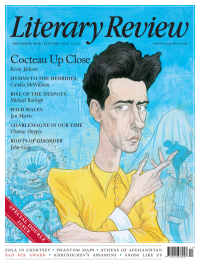Thomas Shippey
No Arthur
Charlemagne
By Johannes Fried (Translated by Peter Lewis)
Harvard University Press 673pp £25
The main facts of Charlemagne’s life are, by early medieval standards, well documented. He was born in around 742, crowned as Emperor of the Romans by Pope Leo III on Christmas Day 800 and died on 28 January 814. A life of him was written fifteen or twenty years later by a monk called Einhard, who had known Charlemagne personally and been his adviser. Some seventy years after this, when stories about Charlemagne could still have been in circulation at second or third hand, another more anecdotal life was written by a monk called Notker, possibly ‘the Stammerer’. (Both, translated by Lewis Thorpe, were published by Penguin Classics in 1969 in a splendid single volume, cheap, short and accessible.) Public events, including Charlemagne’s many campaigns against Lombards, Saxons, Avars and Saracens, were recorded in several series of Frankish annals, while we also have eighty ‘capitularies’ (or legislative collections), a great deal of royal correspondence and many lives of his contemporaries. The overall picture is unlikely to change much.
How does one account, then, for the increasing interest in him, as manifested in this undeniably weighty and exhaustive volume? The answer can be found in the title of Rosamond McKitterick’s life of 2008, Charlemagne: The Formation of a European Identity, and also in the Charlemagne Prize, an annual

Sign Up to our newsletter
Receive free articles, highlights from the archive, news, details of prizes, and much more.@Lit_Review
Follow Literary Review on Twitter
Twitter Feed
It wasn’t until 1825 that Pepys’s diary became available for the first time. How it was eventually decrypted and published is a story of subterfuge and duplicity.
Kate Loveman tells the tale.
Kate Loveman - Publishing Pepys
Kate Loveman: Publishing Pepys
literaryreview.co.uk
Arthur Christopher Benson was a pillar of the Edwardian establishment. He was supremely well connected. As his newly published diaries reveal, he was also riotously indiscreet.
Piers Brendon compares Benson’s journals to others from the 20th century.
Piers Brendon - Land of Dopes & Tories
Piers Brendon: Land of Dopes & Tories - The Benson Diaries: Selections from the Diary of Arthur Christopher Benson by Eamon Duffy & Ronald Hyam (edd)
literaryreview.co.uk
Of the siblings Gwen and Augustus John, it is Augustus who has commanded most attention from collectors and connoisseurs.
Was he really the finer artist, asks Tanya Harrod, or is it time Gwen emerged from her brother’s shadow?
Tanya Harrod - Cut from the Same Canvas
Tanya Harrod: Cut from the Same Canvas - Artists, Siblings, Visionaries: The Lives and Loves of Gwen and Augustus John by Judith Mackrell
literaryreview.co.uk